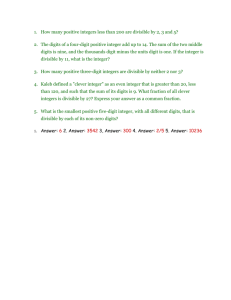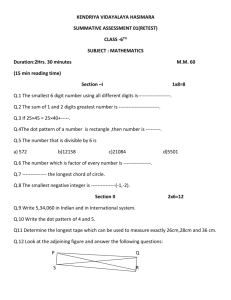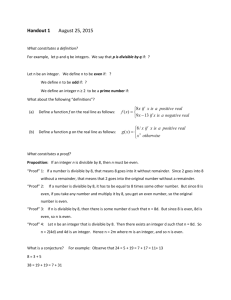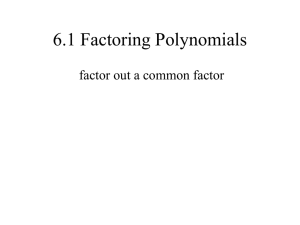SMLE Help
advertisement
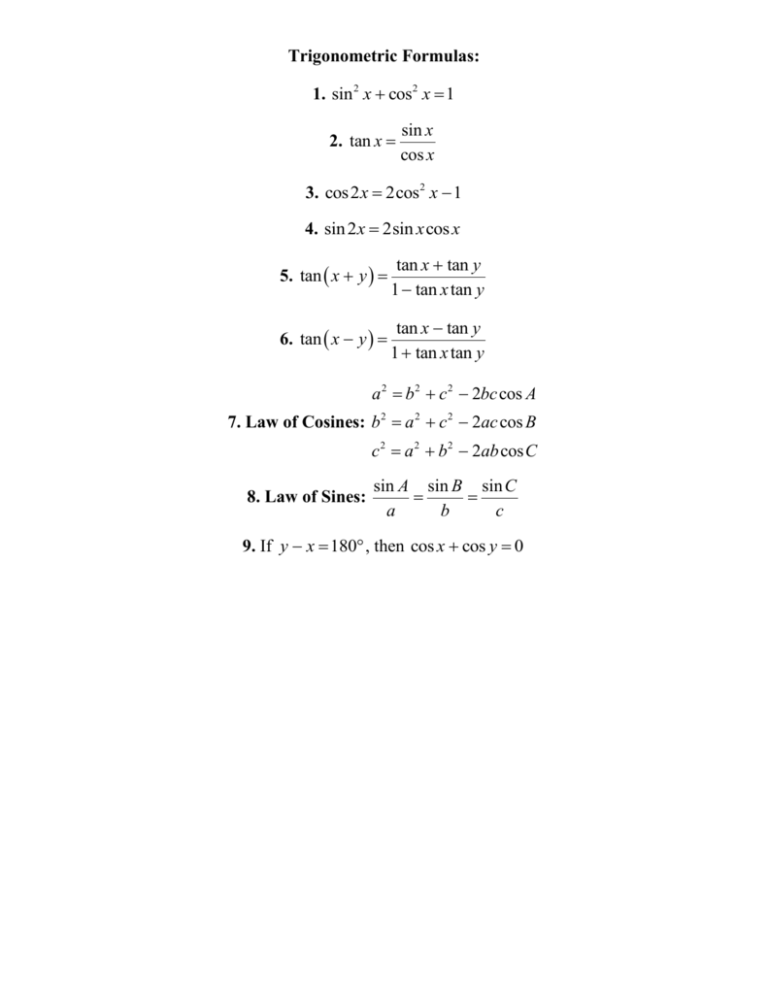
Trigonometric Formulas: 1. sin 2 x cos2 x 1 2. tan x sin x cos x 3. cos 2 x 2cos 2 x 1 4. sin 2 x 2sin x cos x 5. tan x y tan x tan y 1 tan x tan y 6. tan x y tan x tan y 1 tan x tan y a 2 b 2 c 2 2bc cos A 7. Law of Cosines: b 2 a 2 c 2 2ac cos B c 2 a 2 b 2 2ab cos C 8. Law of Sines: sin A sin B sin C a b c 9. If y x 180 , then cos x cos y 0 Algebraic Formulas: 1. 1 2 3 2. 12 22 32 n n2 n n 1 2 n 2n 1 n 1 6 3. a b a 2 2ab b2 2 4. a b a 2 2ab b2 2 5. a 2 b 2 a b a b 6. a 3 b3 a b a 2 ab b 2 7. a 3 b3 a b a 2 ab b 2 8. Geometric Sequences and Series: a, ar , ar 2 , ar 3 , , ar n1 , a ar ar 2 ar 3 ar n1 a ar ar 2 ar 3 ar n1 a 1 r n a ar n first last 1 1 r 1 r a ; 1 r 1 1 r 9. Arithmetic Sequences and Series: a, a d , a 2d , a 3d , , a n 1 d , a a n 1 d first n n 1 last a a d a 2d a 3d a n 1 d na d n 2 2 10. Quadratic Formula: For the equation ax 2 bx c 0 with a, b, and c real numbers and a 0 , the solution(s) are b b 2 4ac given by . If the discriminant, b2 4ac , is positive, then there are two real 2a solutions; if it’s negative, then there are two imaginary solutions; and if it’s zero, then there is one real solution. Logarithmic Properties: 1. logb xy logb x logb y; x, y 0 2. logb x logb x logb y; x, y 0 y 3. logb x r r logb x; x 0 4. log a x logb x logb a 5. blogb x x; x 0 6. logb b x x Geometric Formulas: 1. Area of a triangle: A 12 base height semiperimeter, or Heron’s formula, A s s a s b s c , where s is the abc . 2 2. Area of a parallelogram: A base height 3. Area of a trapezoid: A 12 base1 base2 height 4. Area of a circle: A radius 2 5. Circumference of a circle: C 2 radius diameter 6. Distance between the points x1 , y1 and x2 , y2 : d x2 x1 2 y2 y1 2 7. Midpoint between the points x1 , y1 and x2 , y2 : x1 x2 y1 y2 2 , 2 8. Angle sum of a triangle: The sum of the angles in a triangle is 180 . 9. Pick’s Theorem: In a square lattice, the area contained by a closed figure is equal to the number of interior lattice points plus half the number of boundary lattice points minus 1. Equations of Lines: 1. Point-Slope: y y1 m x x1 2. Two-Point: y y1 y y1 2 x x1 x x 2 1 3. Slope-Intercept: y mx b 4. Intercept-Intercept: x y 1 a b 5. Slope: m y2 y1 x2 x1 6. General Form: If the equation of the line is in general form, Ax By C with B 0 , then the slope of the line is given by A . B Polynomial Properties: 1. Factor Theorem: P a 0 if and only if x a is a factor of P x . 2. Remainder Theorem: When P x is divided by x a , the remainder is P a . 3. Division Theorem: For polynomials D x and N x , there are unique polynomials Q x and R x ( deg R x deg N x ) with D x N x Q x R x . Q x is called the quotient, and R x is called the remainder. 4. Rational Zero Theorem: If P x an x n an1 x n1 a1 x a0 is an nth degree polynomial with integer coefficients, then the rational zeros of P x can be expressed in the form p , where p is a factor of a0 and q q is a factor of an . 5. Properties of Zeros: The n zeros of the nth degree polynomial x n an1 x n a1 x a0 , r1 , r2 , following: r1 r2 rn 1 a0 , r1 r2 n rn an1 , … , rn must satisfy the Fundamental Theorem of Arithmetic: Every positive integer greater than one can be written uniquely as a product of prime factors, i.e. N p1r1 p2r2 pkrk , where p1 , , pk are distinct prime numbers. LCM and GCF: For two whole numbers A and B with A p1r1 p2r2 LCM A, B p1 p2 GCF A, B p1 p2 max r1 ,s1 min r1 , s1 pkrk and B p1s1 p s2 2 max r2 ,s2 pk min r2 , s2 pk The formulas generalize to more than two numbers. max rk , sk min rk , sk pksk , Sets and Counting: For the universal set U 1. n AC n U n A 2. n A 3. n A B B n A n B n A C n A n B n C n A 4. The maximum possible value of n A B B n A C nB C n A B C B is the minimum of n A and n B , and this generalizes to any finite number of sets. 5. The minimum possible value of n A B is n A n B n U if this quantity is positive, and zero otherwise. 6. The number of different subsets of a set with n elements, including the empty set, is 2n . 7. Fundamental Counting Principle: If a decision process consists of k stages with the number of options equal to n1 , n2 , , nk , respectively, then the number of different ways of completing the decision process is n1 n2 nk . 8. Combinations: The number of different subsets with k elements from a set with n elements is n! C . n k n k ! k ! 9. Permutations: The number of different arrangements in a line of k elements from a set with n n! elements(permutations) is n Pk . n k ! The number of different arrangements in a line of n objects in which k1 of the objects are identical, k 2 of the objects are identical,…, k j of the objects are identical, with k1 k2 k j n is n! . k1 ! k2 ! k j ! Graph Properties: 1. Replacing x with x in an equation in the two variables x and y has the effect of reflecting the graph of the solutions of the equation across the y-axis. 2. Replacing y with y in an equation in the two variables x and y has the effect of reflecting the graph of the solutions of the equation across the x-axis. Divisibility Rules: 1. A positive integer is divisible by 2 if and only if its one’s digit is even. 2. A positive integer is divisible by 3 if and only if the sum of its digits is divisible by 3. This process may be repeated. 3. A positive integer is divisible by 4 if and only if the ten’s and one’s digits form a two-digit integer divisible by 4. 4. A positive integer is divisible by 5 if and only if its one’s digit is either a 5 or a 0. 5. A positive integer is divisible by 6 if and only if it’s both divisible by 2 and divisible by 3. 6. A positive integer is divisible by 7 if and only if when you remove the one’s digit from the integer and then subtract twice the one’s digit from the new integer, you get an integer divisible by 7. This process may be repeated. 7. A positive integer is divisible by 7 if and only if when you remove the one’s digit from the integer and then subtract nine times the one’s digit from the new integer, you get an integer divisible by 7. This process may be repeated. 8. A positive integer with more than three digits is divisible by 7 if and only if when you split the digits into groups of three starting from the right and alternately add and subtract these three digit numbers you get a result which is divisible by 7. 9. A positive integer is divisible by 8 if and only if the hundred’s, ten’s, and one’s digits form a three-digit integer divisible by 8. 10. A positive integer is divisible by 9 if and only if the sum of its digits is divisible by 9. This process may be repeated. 11. A positive integer is divisible by 11 if and only if when you remove the one’s digit from the integer and then subtract the one’s digit from the new integer, you get an integer divisible by 11. This process may be repeated. 12. A positive integer is divisible by 11 if and only if when you subtract the sum of the ten’s digit and every other digit to the left from the sum of the one’s digit and every other digit to the left you get a number divisible by 11. This process may be repeated. 13. A positive integer with more than three digits is divisible by 11 if and only if when you split the digits into groups of three starting from the right and alternately add and subtract these three digit numbers you get a result which is divisible by 11. Statistics Formulas: 1. Mean or average: For the group of numbers x1 , x2 , , xn , the mean is x x1 x2 n xn . 2. Median: For the ordered group of numbers x1 x2 xn , if n is odd, then the median is the middle number, and if n is even, then the median is the average of the middle two numbers. 3. Mode: The mode is the most frequently occurring number, if there is one. Probability Formulas: 1. Equally-likely probabilities: If all the outcomes in the sample space, S, are equally-likely to n E occur, then the probability that an event E occurs is given by P E . nS 2. Complementary probabilities: P E C 1 P E . 3. Intersection probability: If the events E and F are independent, then P E F P E P F . This formula generalizes for any finite number of independent events. 4. Union probability: P E F PE PF PE 5. Conditional probability: P E | F PE F . PF F . 6. Geometric probability: If a point is to be chosen at random from a region S, then the area of E probability that the point is in the region E is given by P E . area of S Matrix Multiplication: If the matrix A has n rows and k columns and the matrix B has k rows and m columns, then the matrix product AB is defined and will have n rows and m columns. The entry in the ith row and jth column of AB is the product of the ith row of A with the jth column of B. For example: 1 2 1 2 3 A and B 2 3 , the product AB is defined, has 2 rows and 2 columns, and 4 5 6 3 4 1 1 2 2 3 3 1 2 2 3 3 4 14 20 AB 32 47 . 4 1 5 2 6 3 4 2 5 3 6 4
